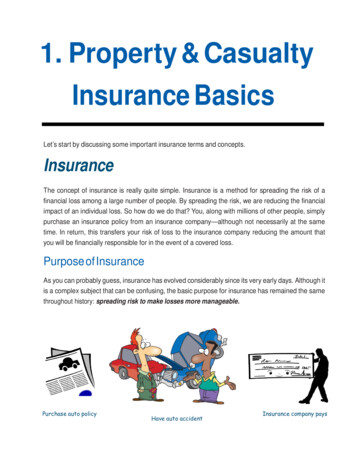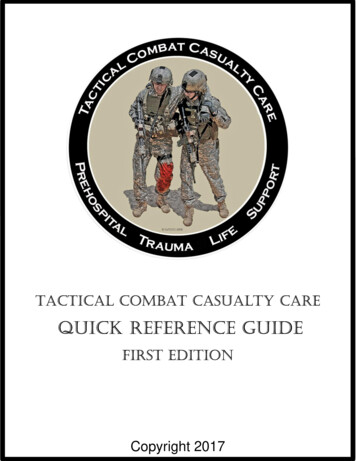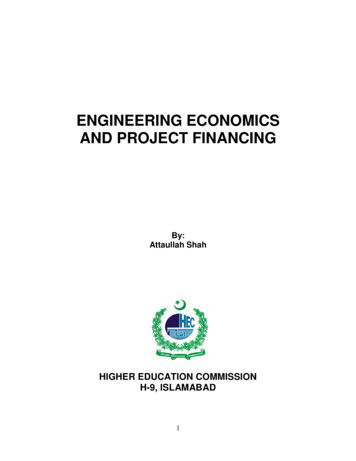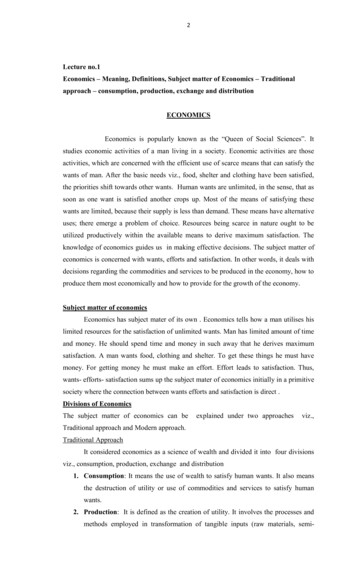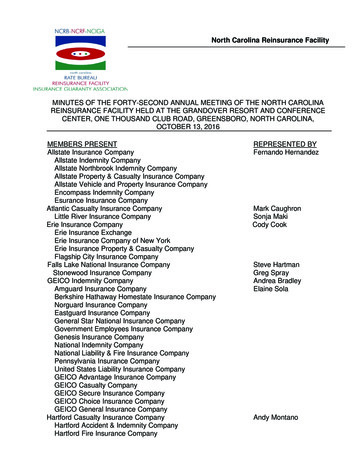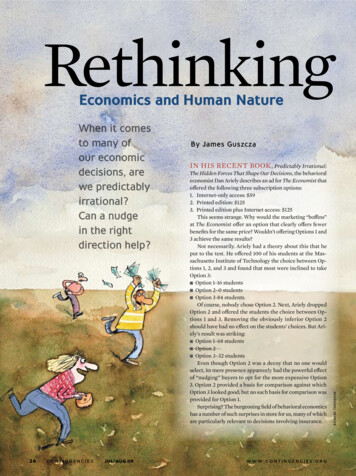
Transcription
RethinkingEconomics and Human Nature2 6 c o n t i n g e n c i e s JUL/AUG.09 By James GuszczaIn his recent book, Predictably Irrational:The Hidden Forces That Shape Our Decisions, the behavioraleconomist Dan Ariely describes an ad for The Economist thatoffered the following three subscription options:1. Internet-only access: 592. Printed edition: 1253. Printed edition plus Internet access: 125This seems strange. Why would the marketing “boffins”at The Economist offer an option that clearly offers fewerbenefits for the same price? Wouldn’t offering Options 1 and3 achieve the same results?Not necessarily. Ariely had a theory about this that heput to the test. He offered 100 of his students at the Massachusetts Institute of Technology the choice between Options 1, 2, and 3 and found that most were inclined to takeOption 3: Option 1–16 students Option 2–0 students Option 3-84 students.Of course, nobody chose Option 2. Next, Ariely droppedOption 2 and offered the students the choice between Options 1 and 3. Removing the obviously inferior Option 2should have had no effect on the students’ choices. But Ariely’s result was striking: Option 1–68 students Option 2 Option 3–32 studentsEven though Option 2 was a decoy that no one wouldselect, its mere presence apparently had the powerful effectof “nudging” buyers to opt for the more expensive Option3. Option 2 provided a basis for comparison against whichOption 3 looked good; but no such basis for comparison wasprovided for Option 1.Surprising? The burgeoning field of behavioral economicshas a number of such surprises in store for us, many of whichare particularly relevant to decisions involving insurance.www . c o n t i n g e n c i e s . o r gRichard Tho mpsonWhen it comesto many ofour economicdecisions, arewe predictablyirrational?Can a nudgein the rightdirection help?
RationalityEcce HomoTo start, a bit of economic history is in order. Until quiterecently, much of the economic theory underpinning regulatory science and business practice has paid little heed tosuch anomalies as Ariely’s Economist example. Indeed acentral concept of classical economics is Homo economicus,the idea that economic actors are perfectly rational beings.They possess both the ability to consistently put a price tagon each of their desires and the judgment and self-controlneeded to achieve their goals. In The Economic Approach toHuman Behavior, University of Chicago Nobel laureate GaryBecker states the matter in an admirably clear way:The combined assumptions of maximizing behavior,market equilibrium, and stable preferences, usedrelentlessly and unflinchingly, form the heart of theeconomic approach as I see it. All human behavior canbe viewed as involving participants who maximize theirutility from a stable set of preferences and accumulatean optimal amount of information and other inputs in avariety of markets.In their recent book Nudge: Improving Decisions AboutHealth, Wealth, and Happiness, University of Chicago behavioral economist Richard Thaler and Harvard University lawprofessor Cass Sunstein paint a much different portrait of economic actors:Whether or not they have ever studied economics, manypeople seem at least implicitly committed to the idea ofHomo economicus, or economic man—the notion thateach of us thinks and chooses unfailingly well, and thusfits within the textbook picture of human beings offeredby economists . If you look at economics textbooks, youwill learn that Homo economicus can think like AlbertEinstein, store as much memory as IBM’s Big Blue, andexercise the willpower of Mahatma Gandhi. Really. But theJUL/AUG.09 c o n t i n g e n c i e s 2 7
Rethinking Rationality c o n t i n u e dfolks that we know are not like that. Real people have troublewith long division if they don’t have a calculator, sometimesforget their spouse’s birthday, and have a hangover on NewYear’s Day. They are not Homo economicus; they are Homosapiens.According to Thaler and Sunstein, Homo economicus is amyth that is too far removed from reality to be a reliable basisfor economic reasoning. Indeed, they turn to modern mythology to illustrate the concept. The dependably logical and wellinformed Mr. Spock from Star Trek is their exemplar of Homoeconomicus. Tellingly, Mr. Spock is not fully human. Their illustration of Homo sapiens, on the other hand, is all too human:Homer from The Simpsons. While their discussion is playful,their point is serious and of fundamental importance. Thalerand Sunstein make the case that because real-world economicagents are more Homeric than Spock-like, economic theoryand practice should dispense with the assumption of perfectrationality in favor of a more psychologically informed pictureof human behavior.In the 1960s, Herbert Simon foreshadowed this point withhis concept of “bounded rationality.” Simon was a polymath whoeventually won the Nobel Memorial Prize in Economic Sciencesin 1978. Like Thaler and Sunstein, Simon pointed out the obvious:When drawing inferences or making decisions, people have neither the luxury of complete information nor a limitless ability toprocess information. Boundedly rational people inevitably drawa line under rational deliberation at a certain point and rely onmental shortcuts. For anyone other than Mr. Spock, finding theoptimal solution is not realistic. Therefore, Simon held that ratherthan maximize, we “satisfice.” That is, we find a solution that givesup less utility than is gained by avoiding excess deliberation.Fair enough, but this perhaps is not enough to subvert thedominant paradigm of economics. Satisficing is, after all, a potentially rational way of maximizing utility once the cost of deliberation is taken into account. Of course, classical economicsdoes not maintain that actual people are omniscient or infallible.It posits only that their guesses diverge from the truth in random ways that average out to zero. James Surowiecki recounteda famous illustration of this in his recent book The Wisdomof Crowds. Francis Galton, the half-cousin of Charles Darwinand inventor of regression analysis, came across a contest inwhich people guessed the weight of an ox that was on displayat a country fair. While each of the 787 individual guesses waswrong, their average came remarkably close to the mark—theox weighed 1,198 pounds and the average of the guesses was1,197. The contestants’ guesses were presumably the productof bounded rationality, but they were still rational.Subsequent work, done in the 1970s by the Israeli-Americanpsychologists Daniel Kahneman and the late Amos Tversky,eventually blossomed into the subject known as behavioral eco-2 8 c o n t i n g e n c i e s JUL/AUG.09 nomics. Tversky died in 1996, and Kahneman, now a professorat Princeton, was awarded the Nobel Memorial Prize in Economic Sciences in 2002. Like Simon, Kahneman and Tverskyfound that people rely on mental shortcuts, which they called“heuristics,” when making decisions. But their work went further. Kahneman and Tversky found that many of these heuristics lead to systematic biases in human cognition and decisionmaking. In particular, Kahneman and Tversky repeatedly foundthat people’s actions are often heavily influenced by context inways that violate the standards of rationality.Today, Kahneman and Thaler are widely regarded as thefounders of behavioral economics, the field that applies ournewfound knowledge of cognitive heuristics and biases to better understand how people make economic decisions. Ariely’sbook is an engaging popular introduction to the field. Thalerand Sunstein’s book explores the implications of behavioraleconomics for law and regulation. Subsequent to the publication of Nudge, Sunstein was chosen by the Obama administration to head the Office of Information and Regulatory Affairs.Irrational ExpectationsAriely’s phrase “predictably irrational” is a memorable way ofexpressing the idea that while our behavior regularly deviatesfrom the Homo economicus ideal, it does so in ways that aren’tpurely capricious “white-noise” deviations from the rationalideal. Rather, we are irrational in systematic ways. Even if thereis not always a method to our madness, there are at least repeatable patterns that can be studied scientifically. Much ofPredictably Irrational is devoted to describing Ariely’s ownexperiments in the realm of human irrationality. Four wellknown biases are: Anchoring Loss aversion The endowment effect The availability heuristic.To illustrate the phenomenon of anchoring, Ariely asked agroup of his MIT students to write the last two digits of theirSocial Security numbers on a piece of paper. The students werethen instructed to record whether they were willing to pay thatmany dollars for items such as a bottle of wine, a book, and abox of chocolates. Next, they were instructed to write downhow much they would be willing to spend for each of the items.Ariely found that there was a significant correlation (roughly30 percent to 40 percent) between their Social Security number digits and the price they were willing to pay for the wine,chocolates, and books!This is an extreme example of “anchoring and adjustment”:When estimating an unknown quantity, people often begin witha number they know—an anchor—and adjust it in the appropriatedirection. For example, when guessing the population of Greenwww . c o n t i n g e n c i e s . o r g
We are irrational in systematic ways. Even if there isnot always a method to our madness, there are at leastrepeatable patterns that can be studied scientifically.Bay, Wis., a citizen of Madison, Wis., might adjust the (known)population of Madison upward and a citizen of Chicago mightadjust that city’s population downward. But people tend not toadjust far enough—Madisonians’ guesses will be on average toolow, and Chicagoans’ guesses will be on average too high.Ariely’s experiment demonstrates the surprising fact thatpeople’s judgments and decisions can be anchored even bypurely arbitrary numbers. Thaler and Sunstein give anotherexample. They asked their students to add 200 to the last threedigits of their phone number and guess the year that Attila theHun invaded Europe (411). Consistent with Ariely, Thalerand Sunstein found that students with high anchors guessedhundreds of years later than students with low anchors. Thephenomenon is surprising and of fundamental importance yeteasily repeatable in a classroom setting.Another interesting aspect of Ariely’s experiment is thefinding of “arbitrary coherence.” Despite their susceptibility tocompletely arbitrary anchors, the students’ preferences wereconsistent in the sense that each student was willing (for example) to pay more for the bottle of wine than for the box ofchocolates. However, the strength of the anchoring effect wassuch that students with the highest anchors were willing to paymore for the chocolates than students with the lowest anchorswere willing to pay for the wine! Such findings give the expression caveat emptor an added meaning.It is not hard to imagine how anchoring is relevant to thebuying and selling of insurance. On the one hand, underwriters use rules of thumb and are susceptible to anchoring effectswhen setting prices for complex risks. On the other, renewing policyholders’ expectations of their future premium arefirmly anchored in their previous term’s premium, regardlessof whether their risk profile has changed. It is interesting tospeculate on the degree to which even arbitrary anchors mightinfluence the amount people are willing to pay for products likeextended-warranty insurance or travel insurance.Another well-known bias is “loss aversion”: The pleasure(utility) of gaining an item is less intense than the pain (disutility) of giving it up. A particularly interesting manifestationof loss aversion is a phenomenon that Kahneman and Thalernamed the “endowment effect”—people often demand more topart with an object than they would be willing to pay to acquireit. To illustrate the endowment effect, Ariely studied a group ofbasketball fans, some of whom had won tickets to a big DukeBlue Devils basketball game in a lottery. Ariely found that thewinners were willing to part with their tickets for an average of 2,400, while the losers were willing to pay an average of only 175. Not a single ticket changed hands. Apparently, the merefact of owning an item—even if that item had been won in apurely random lottery—has a powerful effect on the owner’ssense of its value. Loss aversion and the endowment effect areoften invoked to explain why homeowners fail to set realisticprices on their homes in a soft housing market. It might alsopartially explain why insurers are sometimes reluctant to partwith unprofitable segments of their books of business.The “availability heuristic” is particularly relevant to understanding people’s insurance-buying behavior. Thaler andSunstein describe it thus: People “assess the likelihood of risksby asking how readily examples come to mind.” For example,homicides are more “cognitively available” than suicides, soPROFESSIONAL.COMPETENT.A COMPANYYOU CAN TRUST.PLACING ACTUARIES WORLDWIDELIFE, HEALTH, PROPERTY & CASUALTY,PENSION, ANNUITIESwww.stewartsearch.com 888-JOB-OPENJUL/AUG.09 c o n t i n g e n c i e s 2 9
Rethinking Rationality c o n t i n u e dSuitable for Framing: A Sampling of Cognitive andAnchoring—The tendency to rely too heavily on a(possibly arbitrary) reference point when estimating a quantity or making a decision. For example,people’s estimates of a little-known date in historyare affected if they are first told to add 200 to thelast three digits of their phone numbers.Framing—People’s decisions and actions are influ-enced by the way relevant information is presentedto them.Status Quo Bias—Named by William Samuelson andRichard Zeckhauser, it is the tendency to stick withone’s current situation. For example, students tendto sit at the same desks every day. It is associatedwith one of the greatest marketing failures in history. In blind taste tests, people preferred New Coke tothe original classic Coca-Cola. Yet when confrontedwith the choice between new and old versions inthe stores, people continued to buy old Coke.Halo Effect—When a person is considered talentedAvailability Heuristic—One’s judgment of theprobability of an event is influenced by how readilyan example comes to mind. Likely influential in people’s assessment of the probabilities of such risks ashurricanes, earthquakes, and terrorist attacks.Loss Aversion—The pleasure (utility) of gaining anitem is less than the pain (disutility) of giving it up.Related to the endowment effect.Endowment Effect—People often demand moreto part with an object than they would be willingto pay to acquire it. This may partially explain thestalled real estate market.many people believe (incorrectly) that more people die fromhomicide. The availability heuristic implies that people’s riskjudgments can be manipulated in much the same way as theirpurchasing behavior. This has important implications for insurance-buying behavior. For example, the demand for earthquakeinsurance rises sharply immediately after an earthquake andthen gradually diminishes as memories of the disaster recede.Similarly, psychological experiments have shown that people’srisk perception and demand for flood insurance can be experimentally manipulated by showing subjects photographs offlooded houses. Thaler and Sunstein report that people withacquaintances who have suffered flooding are more likely tobuy flood insurance of their own, regardless of the flood riskthat they actually face.In short, the availability heuristic affects people’s risk perception, which in turn affects their propensity to buy varioustypes of insurance. This even can lead to logical inconsisten-3 0 c o n t i n g e n c i e s JUL/AUG.09 or effective in one area, others tend to attributecomparable talents to him or her in other, unrelatedareas.Optimism Bias (aka the Lake Wobegon Effect)—Thetendency to be overly optimistic about one’s abilities and the outcomes of one’s own actions.Availability Cascades—A chain reaction pro-cess by which a novel idea, or “meme,” gains currency in a social network or society. An exampleis Hurricane Katrina sparking a cascading concernabout climate change. (Note that questioning theevidential significance of Katrina does not suggestthat climate change is not a real threat.)cies in people’s behavior. A simple illustration of the availabilityheuristic is that people tend to believe that words ending in“ing” are more common than words having “n” as their secondto-last letter. Of course this is illogical, but the belief arises because words ending in “ing” more readily come to mind. Theyare more cognitively available than words whose penultimateletter is “n.” Analogously, a 1993 study by a group of Whartonprofessors reported that participants of a study were willingto pay a higher premium for a 100,000 terrorism-insurancepolicy than for a policy that paid the same amount for deathowing to any reason (including terrorism).You’ve Been FramedPhenomena such as anchoring, loss aversion, the endowmenteffect, and the availability heuristic are only the beginning of along list of cognitive and behavioral biases documented by Kahneman and Tversky and their followers (see Page 32 for furtherwww . c o n t i n g e n c i e s . o r g
Behavioral BiasesHerd Behavior—The tendency to be influenced bysocial effects and follow the crowd. Explained bothby peer pressure and by the tendency to assumethat others have information that you don’t have.Herd behavior and availability cascades may partiallyexplain the regular appearance of bubbles in financial markets.Similarly, classical microeconomic theory assumes that thedemand for a good is objective and independent of the supplyof that good. But as Ariely’s wine and chocolate experimentshows, the anchoring effect calls this into question. The demand side can be manipulated by fairly arbitrary supply-sideanchors such as the manufacturer’s suggested retail price or themost expensive item on a menu or wine list. Therefore, Arielysays that contrary to the axioms of microeconomics, “demandis not a separate force from supply.”People’s beliefs and decisions are also affected by the waythe relevant options are framed. Thaler and Sunstein give theexample of an energy conservation campaign. The followingtwo campaigns convey precisely the same information: If you use energy conservation methods, you will save 350per year. If you do not use energy conservation methods, you willlose 350 per year.It turns out that the latter is the more effective campaign.Similarly, telling people that performing a self-examination forexamples). But even these few examples suffice to illustratehow fundamentally and systematically actual human behaviordiverges from the Homo economicus ideal articulated by GaryBecker. Recall that Becker posited that economic actors havea “stable set of preferences.” This seems doubtful in light ofthe large body of evidence amassed over the past 30 years thatpeople’s decisions are powerfully affected by arbitrary anchors,defaults, reference points, and even the semantic connotationsof the ways their choices have been framed.For example, Ariely’s Economist subscriptions story flies inthe face of the assumption that people have stable, well-orderedpreferences. If magazine readers had stable preferences, thepresence of the decoy Option 2 would not affect their purchasingbehavior. Yet it does. It appears that when we make decisions,we do not merely consider an abiding set of well-ordered preferences. Ariely comments, “We look at our decisions in a relativeway and compare them locally to the available alternative.”JUL/AUG.09 c o n t i n g e n c i e s 3 1
Rethinking Rationality c o n t i n u e dskin cancer reduces their risk of cancer is less effective thanwarning them of the increased risk that results from failingto self-examine. Insurers engage in a type of framing all thetime. For example, offering a good-student discount for autoinsurance is logically equivalent to surcharging policyholderswho don’t fall into the good-student category. But few insurerswould adopt the latter option.As if all of this weren’t enough, there is an entirely different class of ways in which people regularly diverge from therational ideal—they succumb to social influences even at thecost of ignoring information from their own senses. So-calledconformity effects have been studied since the 1930s and appear to be fairly ubiquitous. They (at least partially) account forphenomena as disparate as vicissitudes in fashion, the successof anti-littering and anti-graffiti campaigns, and even the decision-making of federal judges. Other well-known conformityeffects, documented in research from Harvard, the Universityof California, San Diego, and other sources, include the fact thatobesity is contagious (controlling for other risk factors, peoplewith overweight friends are more likely to be overweight themselves) and the fact that teenage girls who see their peers havingchildren are more likely (again, all else being equal) to becomepregnant themselves.A disconcerting finding is that even core beliefs appear tobe subject to social influences. For example, Thaler and Sunstein report a study in which people were asked whether theyagreed or disagreed with the statement, “Free speech being aprivilege rather than a right, it is proper for a society to suspendfree speech when it feels threatened.” When this question wasposed individually to people in a control group, only 19 percentagreed with it. However, when another group was told that fourother people agreed with the statement, 58 percent agreed.For a more mundane example, think back to Francis Galton’sox contest. Galton’s contestants were “rational” because theymade their guesses independently of one another. However,had the first contestant uttered an inaccurate guess out loud,it very likely would have anchored others’ guesses, resulting inthe average of the crowd’s guesses being biased. Even worse, ifthe guesses had been made both aloud and in sequence, an “information cascade” might have arisen, resulting in the group’scollective estimate being highly sensitive to the guesses of thefirst few members. Consider this the next time you are in agroup discussing a job candidate or an employee’s year-endreview.Finally, people regularly diverge from the rational idealof Homo economicus in demonstrating a lack of self-control.People have trouble staying on diets, don’t get around to properly organizing their retirement saving plans, and continue tosmoke in spite of the dire and well-publicized risks involved.Thaler and Sunstein report an amusing experiment that drives3 2 c o n t i n g e n c i e s JUL/AUG.09 the point home. Two groups of people in a movie theater weregiven free bags of tasteless, stale, squeaky popcorn. One groupreceived big bags, the other smaller bags. The recipients of thebigger bags ate 53 percent more popcorn, even though none ofthem liked it! One is reminded of a joke from Woody Allen’sAnnie Hall, “Two elderly women are at a Catskill mountainresort, and one of ’em says, ‘Boy, the food at this place is really terrible.’ The other one says, ‘Yeah, I know; and such smallportions.’”Anchors AwayAll of this might be interesting, but, other than the incidentalconnections made above, how does it relate to insurance? Atleast three types of connections are worth considering. Classical economics forms part of the theoretical background of actuarial science, insurance management theory,and regulatory work. Fundamental changes in economicswill probably have ripple effects on academic and appliedactuarial work. Perhaps the most notable development in actuarial sciencein the past decade has been the profession’s embrace ofmodern predictive analytics. Some of the success of predictive modeling in insurance is related to bounded rationalityand the heuristics and biases discovered by Kahneman andTversky and their followers. Thaler and Sunstein point out that an improved understanding of people’s cognitive and behavioral biases canbe used—through what they call “choice architecture”—tohelp people make better decisions. Their point is especiallyrelevant to insurance-purchasing decisions.Let us consider each of these themes in turn.A paradigm shift for economics—If behavioral economics continues its rapid growth in stature, its importance to insurance,as well as medicine, law, regulation, and many other areas ofbusiness, is likely to be substantial and wide-ranging. This isprecisely because behavioral economics strikes at the very heartof classical economic theory.An analogy might be useful. In a sense, the doctrine of rational expectations is reminiscent of the ancient astronomers’ central tenet that planets move in perfectly circular orbits. This notion seemed axiomatic at the time because of the astronomers’prior commitment to the philosophical doctrine that circularmotion is the most “perfect” motion and therefore uniquelysuited to “heavenly” bodies. From a modern perspective, it isthe reasoning that seems circular. Physics ultimately droppedthis philosophically motivated axiom in favor of the more accurate premise that planets move in elliptical orbits. The Newtonian revolution in physics would have been impossible, andwww . c o n t i n g e n c i e s . o r g
physics would have remained metaphysical, had scientistsclung to the doctrine of perfect circular motion.Analogously, Kahneman, Tversky, Thaler, Sunstein, and Ariely urge economists to dispense with the unrealistic and philosophically motivated doctrine of rational expectations in favorof the messy but empirical regularities of behavioral science.If, as Thaler hopes, the word “economics” eventually comes tomean what we today call “behavioral economics,” it is possiblethat the relevance of economics to other fields will be magnified considerably.For insurers, this has potential relevance to any point atwhich economic theory impinges on insurance research, marketing, or actuarial work. For example, much of the existingacademic literature on the underwriting cycle has been writtenfrom the point of view of rational expectations and efficient markets. This might leave potentially valuable explanations of theunderwriting cycle on the table. An early suggestion along theselines came in a 1993 presentation by David Skurnick on potentialexplanations for the underwriting cycle. He ended his list with aprescient observation about psychology. He commented:Insurance managements are human beings. We don’t alwaysmake rational decisions. We’re unduly influenced by recentevents, even when we’re making long-term plans based onlong-term odds.In other words, we rely on the availability heuristic whenassessing risks and are vulnerable to the resulting biases.Skurnick also suggests conformity effects and herd behavioras further influences on insurance management decisions. Suchcomments are rare in academic literature on the underwritingcycle but might hold the key to an improved understandingwith significant management implications.A second example is on the consumer side of the equation.Recall the implication of Ariely’s Economist example and related anchoring experiments—contrary to classical economics,consumers’ demand functions are neither stable nor independent of supply and other contextual factors. This is relevantknowledge when analyzing policyholders’ retention behaviorand sensitivity to price changes.Analyzing Analytics—As I argued in these pages last year(“Analyzing Analytics,” July/August 2008), a major reason whypredictive models have become ubiquitous in disparate realmsof business, medicine, sports, entertainment, government, andeducation is that they compensate for the “predictable irrationality” of their users. Just as eyeglasses help us see better,predictive models help us make better decisions.Michael Lewis’ book Moneyball vividly recounts how statistical analysis was able to outperform the professional judg-JUL/AUG.09 c o n t i n g e n c i e s 3 3
Rethinking Rationality c o n t i n u e dIf employees are automatically enrolled in (and given the option to optout of) a 401(k)-type savings plan, they will set aside more money than ifthe plan defaults to a zero contribution and requires active enrollment.Merely changing the plan’s default nudges people to save more for retirement.ment of traditional baseball scouts at selecting top players. Inbaseball, the market for talent had been inefficient in large partbecause it was dominated by intuition-based decision-making.Similarly, my experience and that of my colleagues in helpinginsurers build and implement predictive models have demonstrated that the often subjective methods used by underwritersto select and price risks can be improved through the judicioususe of predictive models. That these predictive models provideimproved accuracy, consistency, and segmentation power is—inretrospect—unsurprising given that underwriters are, like therest of us, Homo sapiens, not Homo economicus.Using predictive models to improve insurance underwritingdecisions is therefore, like Moneyball, a case study in behavioraleconomics.Fraught Choices and Better Choice Architecture—Nudge ismore than a popularization of behavioral economics. Discussions of behavioral economics often dwell on the ways in whichpeople make suboptimal or irrational decisions. Thaler andSunstein take the conversation to the next level—they suggestthat the findings of behavioral science can be strategically employed to prompt people to make better decisions. Put simply, ifwe know that people tend to select the default when presentedwith a long list of confusing options, then let us set the defaultwith their best interest in mind.A motivating example is the line at a cafeteria. People tend tostock up on
irrational Expectations Ariely's phrase "predictably irrational" is a memorable way of expressing the idea that while our behavior regularly deviates from the Homo economicus ideal, it does so in ways that aren't purely capricious "white-noise" deviations from the rational ideal. Rather, we are irrational in systematic ways. Even if .

